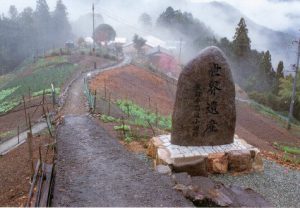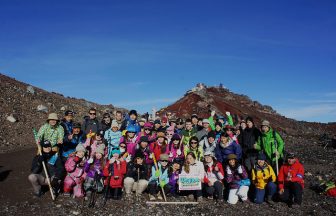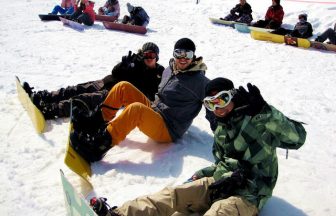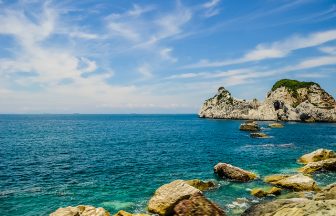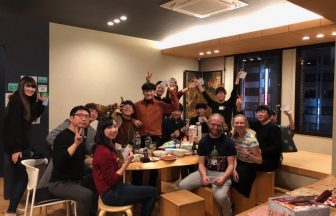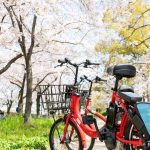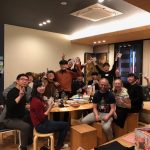Pilgrimage Through the Mountains – Kumano Kodo
by Jordan Mounteer
I’d heard about the Kumano Kodo before I left to Japan, but it never occurred to me that I’d actually be hiking one of the most ancient and wild pilgrimage trails. My opportunity came during a summer vacation period, and I spent several days doing my research coming from Canada, I was well acquainted with hiking and being outdoors, but I wasn’t sure what to expect from Japan. The Kumano Kodo is affiliated with the ascetic practice of Shugendo, a form of spiritual meditation combined with strenuous physical exertion that finds its roots in both Buddhist, Shinto, and shamanistic traditions. Situated along the Kii Hanto peninsula south of Osaka, the Kumano Kodo actually consists of three separate trails which all meet up with the three Grand Shrines of Kumano. But the more I looked into it the more I realized that out of all of them, I was most attracted to the Kohechi Route.
Unlike the Iseji and Kiji Routes, which begin at Ise and Tanabe respectively, the Kohechi Route is one of the more difficult trails and requires a winding train ride that takes you up into the mountains to the Buddhist sanctuary of Koyasan. Mount Koya has long been the home of the esoteric form of Shingon Buddhism first started by Kukai back in the 819, and as I got off the bus and began to pass monks and temples enclosed by cypress trees and sugi cedars I knew I’d chosen correctly. Nature has always called to me, so I knew that this pilgrimage would be an opportunity for me to get in touch with the wilderness, and here the monks and townsfolk seemed at peace with their surroundings.
Starting off by myself, I fumbled through the paper maps I’d printed off, trying to get my bearing. A few friendly people out for a day walk nodded at me as I passed, and before long I was following a dirt path onto a high ridge. Almost at once my mind began to drift as my body carried me up and down switchbacks, and I lost myself in the smells of the forest. The hours rolled by, and before long I was sweating, but I felt alive and energetic. At one point I had to follow an old paved road, and as I came around the corner was confronted with an entire television crew walking toward me they seemed completely out of place in the middle of nowhere, but it soon became clear they were filming a nature segment for NHK1. Upon seeing me they instantly assaulted me with a barrage of questions and pointed a camera in my face, and I struggled to answer them with my limited Japanese. And then they were gone only a week later would one of my students tell me that they’d seen me on television!
The second day it rained on me as I climbed up one of three steep thousand-meter passes on the 70 kilometre pilgrim route. My shoes sloshed with each step, and more than once I nearly slipped off the narrow path, and was only able to save myself at the last moment by gripping a nearby branch. As I descended into a narrow valley, I took a break next to the old ruins of farmhouse that had overgrown with moss and ferns. Unlike the trails back in Canada that I was used to, these trails were hundreds of years old and I could almost feel the history as I imagined monks, clad only in their simple tunics, struggling over the same stone steps in braided sandals.
On the way up the second pass I stopped for a breather and noticed a paper note, clamped under a stone, that read ‘Minna Ganbatte!’: Good luck Everyone! Smiling, and with new motivation, I began the long ascent to the top of Miuratoge where a small termite-riddled gazebo looked out across the mountains. Breathing hard, my legs were shaking as I dropped my backpack and allowed myself a moment to appreciate the natural beauty and splendor of a place few Japanese, let alone foreigners, ever experience.
Thankfully, by the third day the rain had let up and I ended up on road which wound itself beside a river for several kilometers. Old women would peek their heads out the window to smile and wave and school children giggled and tried to practice their English with me when I stopped next to a vending machine and slurped back a hot can of coffee. Eventually the trail split off from the road and crossed a rickety looking wire bridge, leading up to the next and final pass which was called Hinokitoge. Heavy clouds drooped down from the peaks the higher I got and I took the opportunity to stop near the site of a long-since ruined teahouse for lunch. Once upon a time pilgrims would stop here to enjoy a cup of matcha before continuing on, and whether it was because I was alone or because of the sound of the wind through the trees, I almost felt as if their ghosts were watching me.
Every hundred meters or so I would spot a jizo statue off the path, stone idols of different Bodhisattvas, and would stop to offer a small prayer before continuing on. Time becomes an abstraction when you walk long enough, and before I knew it I’d come down the other side and reached the portal that connected the Kohechi to the other routes. Suddenly I saw more and more people, many of them day-trippers, but several other pilgrims as well who’d spent several days walking through the mountains. It had taken me three days through harsh weather and over perilous stretches of wilderness, but nothing could compare to the exhilaration I felt as I cleared a hill and was able to look down at the tall torii gates of Hongu Taisha.
Although physically exhausted and starving for a hot meal, I couldn’t help feeling proud of myself, not just for accomplishing the hike itself, but also for being able to participate in something that had so much sacredness attached to it. That night I would camp along the Shingu River, listening to the sounds of raindrops trailing down the branches of trees, the swishing of reeds in the wind, and the burbling of water, and for the first time since setting out I could almost believe they were as alive as me.

